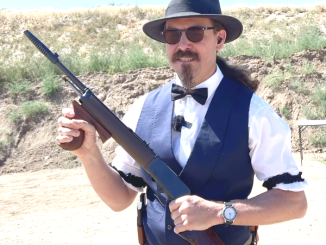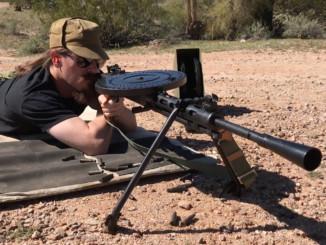I was looking through our reference library yesterday, and realized that we hadn’t mentioned at Hatcher’s Notebook before – which is a glaring oversight. Julian S. Hatcher (Captain Hatcher during WWI, and Major General Hatcher by WWII) was a presence in the US Ordnance Department for nearly 30 years, and was actually interested in firearms technology enough to record much of what was going on. He was involved in the US procurement of light machine guns, and development of early semiauto service rifles. In addition to all this, he had a curious mind and engaged in a number of interesting firearms experiments, the results of which are recorded in Hatcher’s Notebook.
Hatcher’s Notebook is an indispensable reference for anyone interested in early 20th century firearms development, and I really can’t recommend is highly enough. Both hardback and paperback editions are still in print, and easily available, so pick up your copy today:
Hardcover
Paperback




Overall it is a really great book and gives good insight into many of the choices made by the US Army during his time in. The bits on the development of the Pederson device and Garand’s rifle are worth the price by themselves. That said, it’s unfortunate that in the later section he toes the ordinance party line regarding the disastrous M14 procurement. His praise of the god-awful M60 is almost as unfortunate as his dissing of the AR-15.
Hatcher retired in 1946, so he was only parroting what he was told by former colleagues about post WW2 programs.
Indeed, if M14 and later are your field of interest, Hatcher’s book is not for you. But in all other respects, this book is unequalled in its wealth of information regarding all aspects of U.S. military arms and ammunition from primer mixes to ballistics. (Only published firing table for .276 Pedersen I know of, to name just one example.) It has a most excellent index that leads you to even tiny bits of information.
I too can’t recommend it highly enough.
The Notebook is not the only Hatcher book. Viewers of this site will probably be interested in his first commercially-published book “Machine Guns”, with editions dating 1917 & 1918. Hatcher is very probably the author of the anonymous “Handbook of the Benet-Mercie Machine Rifle, Model of 1909, with Pack Outfits and Accessories”. Hatcher’s “The Book of the Garand” (1948) is a another classic.
Major Hatcher was actually fairly open minded by U.S. Ordnance Corps standards. You need to read the story of General William Crozier and the Lewis LMG to really understand just how obstructionist the Ordnance Corps could be.
I think the M60 LMG was developed as an apology to Lewis, it just did not get vetted by a professional testing program. Te M14 program was hobbled by the loss of manufacturing technology experts in the Ordnance Corps after WW II. Only TRW could get the M14’s manufacture right. And the AR-15 program was an unmitigated disaster at its inception with loud protests from the soldiers and Congressional hearings in the late 1960’s.
Right after Hatcher retired, the entire U.S. Ordnance Corps was dissolved and was not reestablished for 20 years. This probably contributed to the AR-15’s disasterous launch, although the ‘not invented here’ mindset certainly played a role as well.
If you ever get a chance, read Crozier’s book. He documents the Lewis controversy in great detail. I believe that the reality was that Lewis hated Crozier a lot more than Crozier hated Lewis.